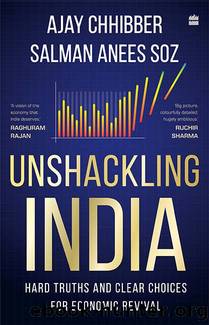Unshackling India by Ajay Chhibber

Author:Ajay Chhibber
Language: eng
Format: epub
Tags: null
Publisher: HarperCollins
Published: 2021-01-15T00:00:00+00:00
Sources: World Development Indicators, World Bank; National Statistical Office, Government of India.
India confronts what Dani Rodrik called âpremature deindustrializationâ (figure 13.2). The phenomenon of deindustrialization is familiar to more advanced economies, where employment share of manufacturing has been on the decline for decades.13 With the exception of some countries in Asia, low- and middle-income countries around the world have experienced âfalling manufacturing shares in both employment and real value added, especially since the 1980sâ.14 While industrialization peaked in western European countries at income levels of around $14,000 (in 1990 dollars), âIndia and many sub-Saharan African countries appear to have reached their peak manufacturing employment shares at income levels of $700â.15 This is not good news for poor countries, because industrialization is a key path to rapid growth and allows absorption of excess rural workers in urban factories where they may find more productive employment.16
Rodrikâs findings found resonance in a 2017 World Bank report, which suggests that new technologies are reshaping the manufacturing landscape and that the old model that utilized low-wage labour may no longer be available to developing countries such as India.17 This report argues that technologies such as âadvanced robotics, industrial automation and 3D printing are changing the landscape of global manufacturingâ. The report also notes that traditional definitions of what constitutes an attractive manufacturing location are also changing with companies focusing on those areas where modern technologies can be better leveraged.18
But what about Bangladesh?
While Rodrikâs observations apply to many developing economies, there are exceptions like Bangladesh and Vietnam. Manufacturing value added as a share of GDP is at an all-time high of 19 per cent in Bangladesh. In Vietnam, this share has gone from less than 13 per cent in 2010 to almost 16.5 per cent in 2019. Why do these countries not fit Rodrikâs deindustrialization storyline? More importantly, what should Indiaâs strategy for the future be, given the jockeying for leadership of the Fourth Industrial Revolution?
Letâs deal first with Indiaâs failure to boost manufacturing through initiatives such as âMake in Indiaâ. Raghuram Rajan, the former governor of RBI, was an early critic of the initiative. Rajan argued that an incentive-driven, export-led growth or an import-substitution model was not appropriate for the times. He felt that global economic conditions were not very conducive to accommodating another âexport-led Chinaâ. Rajan also cautioned against âpicking a particular sector such as manufacturing for encouragement simply because it has worked well for Chinaâ. From his perspective, India is developing differently and at a different time than China and that âwe should be agnostic about what will workâ.
Others were sceptical as well. The Economist magazine noted that while the government correctly argued for a skilled workforce, there was no vision for improving the underlying education sector. Similarly, while the need for improving infrastructure was clear and accepted in policy circles, there were no details about where the money would come from. Some argued that âMake in Indiaâ was too ambitious. The growth rates needed to achieve the governmentâs manufacturing targets would be in the 12â14 per cent range.
Download
This site does not store any files on its server. We only index and link to content provided by other sites. Please contact the content providers to delete copyright contents if any and email us, we'll remove relevant links or contents immediately.
Hit Refresh by Satya Nadella(8856)
When Breath Becomes Air by Paul Kalanithi(8040)
The Girl Without a Voice by Casey Watson(7604)
A Court of Wings and Ruin by Sarah J. Maas(7262)
Do No Harm Stories of Life, Death and Brain Surgery by Henry Marsh(6688)
Shoe Dog by Phil Knight(4892)
Hunger by Roxane Gay(4678)
A Higher Loyalty: Truth, Lies, and Leadership by James Comey(4552)
The Rules Do Not Apply by Ariel Levy(4524)
Everything Happens for a Reason by Kate Bowler(4477)
Tuesdays with Morrie by Mitch Albom(4404)
The Immortal Life of Henrietta Lacks by Rebecca Skloot(4257)
How to Change Your Mind by Michael Pollan(4113)
Millionaire: The Philanderer, Gambler, and Duelist Who Invented Modern Finance by Janet Gleeson(4099)
All Creatures Great and Small by James Herriot(3987)
Tokyo Vice: An American Reporter on the Police Beat in Japan by Jake Adelstein(3865)
Elon Musk by Ashlee Vance(3858)
The Money Culture by Michael Lewis(3849)
Man and His Symbols by Carl Gustav Jung(3845)
